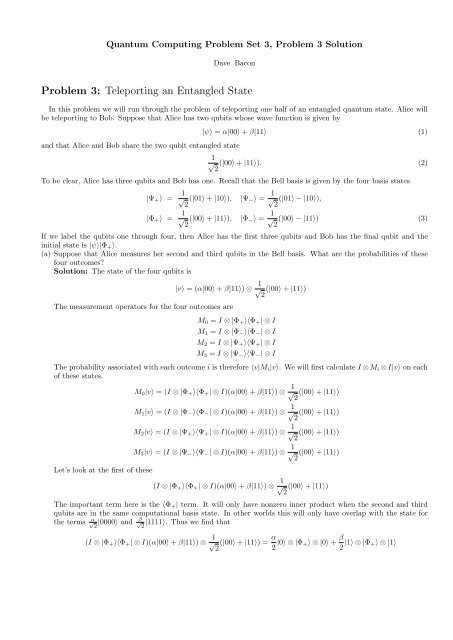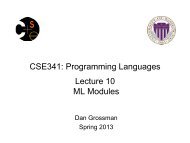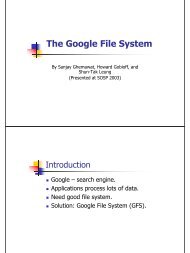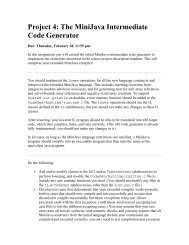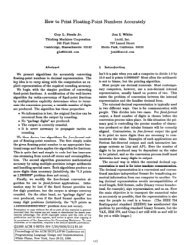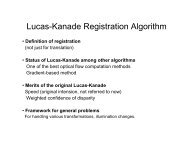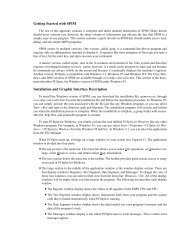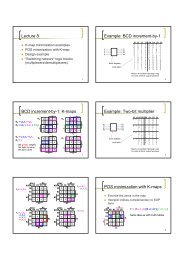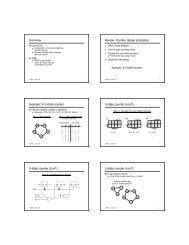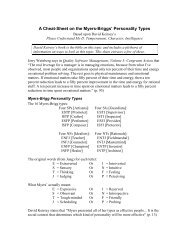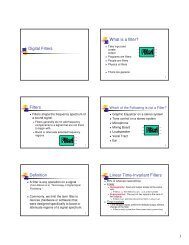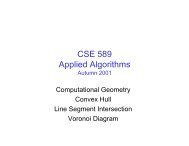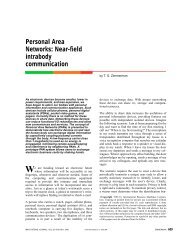Problem 3: Teleporting an Entangled State
Problem 3: Teleporting an Entangled State
Problem 3: Teleporting an Entangled State
Create successful ePaper yourself
Turn your PDF publications into a flip-book with our unique Google optimized e-Paper software.
Qu<strong>an</strong>tum Computing <strong>Problem</strong> Set 3, <strong>Problem</strong> 3 Solution<br />
Dave Bacon<br />
<strong>Problem</strong> 3: <strong>Teleporting</strong> <strong>an</strong> Ent<strong>an</strong>gled <strong>State</strong><br />
In this problem we will run through the problem of teleporting one half of <strong>an</strong> ent<strong>an</strong>gled qu<strong>an</strong>tum state. Alice will<br />
be teleporting to Bob. Suppose that Alice has two qubits whose wave function is given by<br />
<strong>an</strong>d that Alice <strong>an</strong>d Bob share the two qubit ent<strong>an</strong>gled state<br />
|ψ〉 = α|00〉 + β|11〉 (1)<br />
1<br />
√ 2 (|00〉 + |11〉). (2)<br />
To be clear, Alice has three qubits <strong>an</strong>d Bob has one. Recall that the Bell basis is given by the four basis states<br />
|Ψ+〉 = 1<br />
√ 2 (|01〉 + |10〉), |Ψ−〉 = 1<br />
√ 2 (|01〉 − |10〉),<br />
|Φ+〉 = 1<br />
√ 2 (|00〉 + |11〉), |Φ−〉 = 1<br />
√ 2 (|00〉 − |11〉) (3)<br />
If we label the qubits one through four, then Alice has the first three qubits <strong>an</strong>d Bob has the final qubit <strong>an</strong>d the<br />
initial state is |ψ〉|Φ+〉.<br />
(a) Suppose that Alice measures her second <strong>an</strong>d third qubits in the Bell basis. What are the probabilities of these<br />
four outcomes?<br />
Solution: The state of the four qubits is<br />
The measurement operators for the four outcomes are<br />
|v〉 = (α|00〉 + β|11〉) ⊗ 1<br />
√ 2 (|00〉 + |11〉)<br />
M0 = I ⊗ |Φ+〉〈Φ+| ⊗ I<br />
M1 = I ⊗ |Φ−〉〈Φ−| ⊗ I<br />
M2 = I ⊗ |Ψ+〉〈Ψ+| ⊗ I<br />
M3 = I ⊗ |Ψ−〉〈Ψ−| ⊗ I<br />
The probability associated with each outcome i is therefore 〈v|Mi|v〉. We will first calculate I ⊗ Mi ⊗ I|v〉 on each<br />
of these states.<br />
M0|v〉 = (I ⊗ |Φ+〉〈Φ+| ⊗ I)(α|00〉 + β|11〉) ⊗ 1<br />
√ (|00〉 + |11〉)<br />
2<br />
Let’s look at the first of these<br />
M1|v〉 = (I ⊗ |Φ−〉〈Φ−| ⊗ I)(α|00〉 + β|11〉) ⊗ 1<br />
√ 2 (|00〉 + |11〉)<br />
M2|v〉 = (I ⊗ |Ψ+〉〈Ψ+| ⊗ I)(α|00〉 + β|11〉) ⊗ 1<br />
√ 2 (|00〉 + |11〉)<br />
M3|v〉 = (I ⊗ |Ψ−〉〈Ψ−| ⊗ I)(α|00〉 + β|11〉) ⊗ 1<br />
√ 2 (|00〉 + |11〉)<br />
(I ⊗ |Φ+〉〈Φ+| ⊗ I)(α|00〉 + β|11〉) ⊗ 1<br />
√ 2 (|00〉 + |11〉)<br />
The import<strong>an</strong>t term here is the 〈Φ+| term. It will only have nonzero inner product when the second <strong>an</strong>d third<br />
qubits are in the same computational basis state. In other worlds this will only have overlap with the state for<br />
the terms α √ 2 |0000〉 <strong>an</strong>d β √ 2 |1111〉. Thus we find that<br />
(I ⊗ |Φ+〉〈Φ+| ⊗ I)(α|00〉 + β|11〉) ⊗ 1<br />
√ 2 (|00〉 + |11〉) = α<br />
2 |0〉 ⊗ |Φ+〉 ⊗ |0〉 + β<br />
2 |1〉 ⊗ |Φ+〉 ⊗ |1〉
Next we need to take the inner product of this state with 〈v|. By exp<strong>an</strong>ding out 〈v| <strong>an</strong>d the above state we find<br />
Similarly we c<strong>an</strong> calculate the other Mi|v〉’s. These are<br />
〈v|M0|v〉 = α∗α 4 + β∗β 1<br />
=<br />
4 4<br />
(I ⊗ |Φ−〉〈Φ−| ⊗ I)(α|00〉 + β|11〉) ⊗ 1<br />
√ 2 (|00〉 + |11〉) = α<br />
2 |0〉 ⊗ |Φ−〉 ⊗ |0〉 − β<br />
2 |1〉 ⊗ |Φ−〉 ⊗ |1〉<br />
(I ⊗ |Ψ+〉〈Ψ+| ⊗ I)(α|00〉 + β|11〉) ⊗ 1<br />
√ 2 (|00〉 + |11〉) = α<br />
2 |0〉 ⊗ |Ψ+〉 ⊗ |1〉 + β<br />
2 |1〉 ⊗ |Ψ+〉 ⊗ |0〉<br />
(I ⊗ |Ψ−〉〈Ψ−| ⊗ I)(α|00〉 + β|11〉) ⊗ 1<br />
√ 2 (|00〉 + |11〉) = α<br />
2 |0〉 ⊗ |Ψ−〉 ⊗ |1〉 − β<br />
2 |1〉 ⊗ |Ψ−〉 ⊗ |0〉<br />
Taking the inner products withe 〈v|, yields<br />
〈v|M1|v〉 = α∗α 4 + β∗β 1<br />
=<br />
4 4<br />
〈v|M2|v〉 = α∗α 4 + β∗β 1<br />
=<br />
4 4<br />
〈v|M1|v〉 = α∗α 4 + β∗β 1<br />
=<br />
4 4<br />
Thus the probability of all four outcomes is 1<br />
4 .<br />
(b) What is the full qu<strong>an</strong>tum wave function for all four qubits after Alice measures in the Bell basis for each of these<br />
four outcomes?<br />
Solution: The wave function for each of the four qubits is given by<br />
|vi〉 = (I ⊗ Mi ⊗ I)|v〉<br />
.<br />
P r(i)<br />
In our case, P r(i) is 1<br />
2 . We have calculated these states in the previous part. We just need to divide by this<br />
probability. The states are thus<br />
|v0〉 = α|0〉 ⊗ |Φ+〉 ⊗ |0〉 + β|1〉 ⊗ |Φ+〉 ⊗ |1〉<br />
|v1〉 = α|0〉 ⊗ |Φ−〉 ⊗ |0〉 − β|1〉 ⊗ |Φ−〉 ⊗ |1〉<br />
|v2〉 = α|0〉 ⊗ |Ψ+〉 ⊗ |1〉 + β|1〉 ⊗ |Ψ+〉 ⊗ |0〉<br />
|v3〉 = α|0〉 ⊗ |Ψ−〉 ⊗ |1〉 − β|1〉 ⊗ |Ψ−〉 ⊗ |0〉<br />
(c) Show that if Alice gets the measurement outcome corresponding to |Φ+〉, then the state of the first qubit <strong>an</strong>d the<br />
fourth qubit is |ψ〉.<br />
Solution: The wave function in this case is |v0〉 from the previous problem,<br />
|v0〉 = α|0〉 ⊗ |Φ+〉 ⊗ |0〉 + β|1〉 ⊗ |Φ+〉 ⊗ |1〉<br />
Label each of the qubits that the state is acting on as 1, 2, 3 or 4.<br />
Which we c<strong>an</strong> reexpress as<br />
which is separable across the 14, 23 divide:<br />
Which, as claimed, is the state |ψ〉 for qubits 1 <strong>an</strong>d 4.<br />
|v0〉 = α|0〉1 ⊗ |Φ+〉23 ⊗ |0〉4 + β|1〉1 ⊗ |Φ+〉23 ⊗ |1〉4<br />
|v0〉 = α|00〉14 ⊗ |Φ+〉23 + β|11〉14 ⊗ |Φ+〉23<br />
|v0〉 = (α|00〉14 + β|11〉14) ⊗ |Φ+〉23<br />
2
(d) Show that if Alice gets the measurement outcome corresponding to |Ψ+〉, then the state of the first qubit <strong>an</strong>d the<br />
fourth qubit is (I ⊗ X)|ψ〉.<br />
Solution: This calculation is similar to the previous problem. If we carry out the same procedure of relabeling<br />
for |v2〉, we end up with<br />
|v2〉 = (α|01〉14 + β|10〉14) ⊗ |Ψ+〉23<br />
But notice that (I ⊗ X)|ψ〉 = α|01〉 + β|10〉. But this is just the state we have in our expression for |v2〉.<br />
(e) Describe a procedure for teleporting one half of Alice’s ent<strong>an</strong>gled state |ψ〉. That is, show how Alice c<strong>an</strong> send two<br />
classical bits of communication to Bob <strong>an</strong>d Bob c<strong>an</strong> apply <strong>an</strong> appropriate unitary operation, such that at the end<br />
of the procedure, the first <strong>an</strong>d fourth qubits are in the state |ψ〉. (Notice that we have half solved this problem<br />
using the results in part (c) <strong>an</strong>d part (d).)<br />
Solution: We see that if Alice carries out the Bell basis measurement described in the problem (on the second<br />
<strong>an</strong>d third qubits), then already we sometimes teleport the state. In particular if the outcome of the Bell basis<br />
measurement is |P hi+〉, then the state is, as desired, the original ent<strong>an</strong>gled state, but now shared between the<br />
1 <strong>an</strong>d 4 qubit. If the outcome was |Ψ+〉, then the state was |ψ〉 except for the fact that we needed to apply X<br />
to Bob’s qubit. Similarly we c<strong>an</strong> calculate that if the outcome was |Φ−〉, then the first <strong>an</strong>d forth qubits have<br />
the wave function (I ⊗ Z)|ψ〉. If the outcome was |Ψ−〉, then the first <strong>an</strong>d forth qubits have the wave function<br />
(I ⊗ Z)(I ⊗ X)|ψ〉. Thus we c<strong>an</strong> perform teleportation just as we did in st<strong>an</strong>dard qubit. In particular, Alice<br />
sends two bits to Bob corresponding to her Bell basis outcome. Depending on what Bob gets, he then applies the<br />
appropriate unitary to his qubit to product |ψ〉 stored between the first <strong>an</strong>d forth qubit. His rules are: outcome<br />
|Φ+〉: do nothing, outcome |Φ−〉, apply a Z, outcome |Ψ+〉: apply X, <strong>an</strong>d outcome |Ψi〉, apply a ZX.<br />
3


